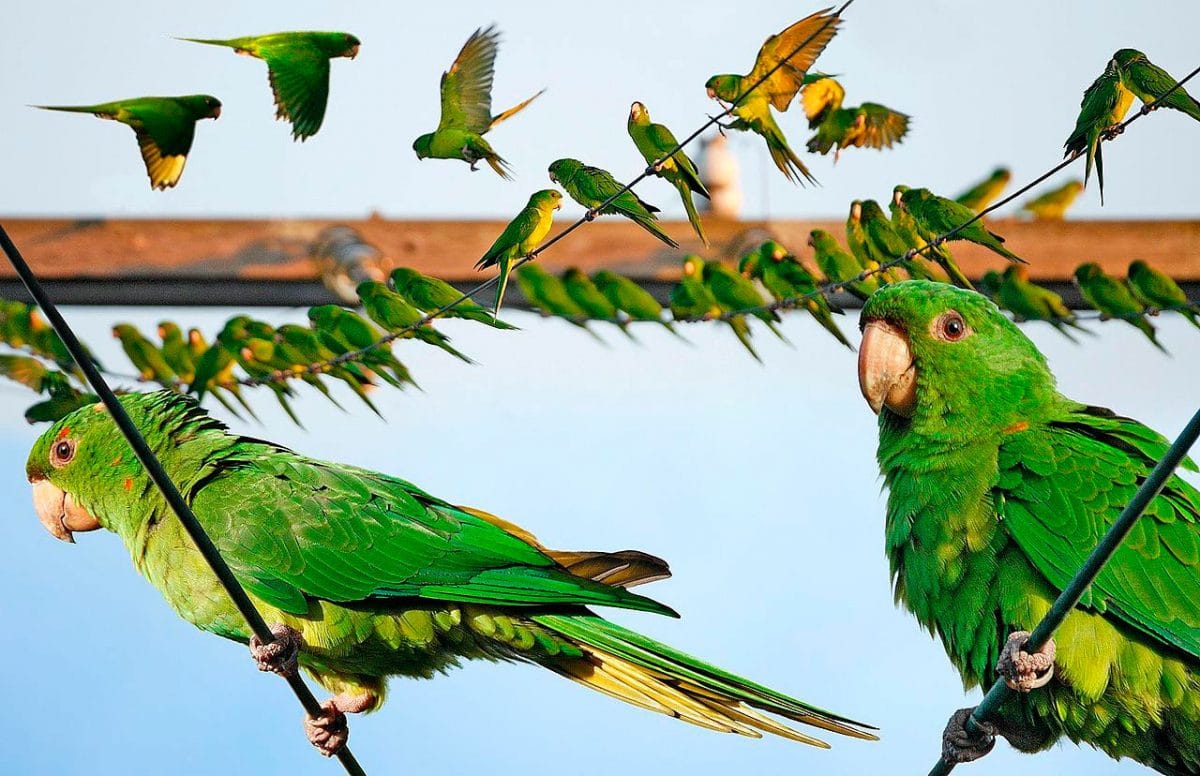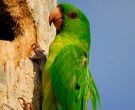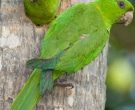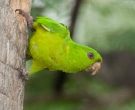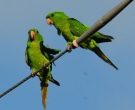Content |
|---|
Description:
Among 28 and 30.5 cm.. of length and a weight of 232 g..
The Green Parakeet (Psittacara holochlorus) is a medium-sized Parrot with the wings in sharp form and the tail long and stitch. Its plumage is bright green, and can present several pens red or orange in the neck. In general, the underwing-coverts are metallic greenish-yellow color, While the the flight feathers and the bottom sides of the the tail feathers are yellow-olive. Presents a eye ring pale beige and the irises orange, the legs yellowish brown.
It has no sexual dimorphism.
The immature has irises Brown color.
- Sound of the Green Parakeet.
Subspecies description:
-
Psittacara holochlorus brewsteri
(Nelson, 1928) – Plumage, in general, darker green than that of the species nominal, with yellowish green tint and bluish suffusion at the crown.
-
Psittacara holochlorus holochlorus
(Sclater,PL, 1859) – The species nominal.
Habitat:
Video – "Green Parakeet" (Psittacara holochlorus) |
|---|
The Green Parakeet, as well as their subspecies, avoid moist lowland forests; Instead, prefer deciduous forests and gallery forests, scrub, clear and the edges of the forest.
In East Mexico, mainly seen in upland forest with some movements toward deciduous forests at elevations lower than during the non-breeding season. Registered to 2.100 meters in Mexico (the subspecies “brewsteri” at altitudes between 1,250 and 2,000m).
Views in flocks outside the breeding season, sometimes in groups of more of 100 birds, being larger groupings in places where food is abundant.
Reproduction:
The nests of the Green Parakeet they are located in tree cavities (for example, cavities made by woodpeckers), crack in rocks, holes in buildings or termite mounds. Colonial nesting reported in caves in the East of Mexico.
The breeding season has been recorded in the month of January to the East of Mexico (young in the nest); in April in Tamaulipas, to the South of Mexico.
The clutch most common consists of four eggs.
Food:
Diet Green Parakeet is based on seeds, nuts, berries and fruits; reported foods include the fruits of Myrica mexicana, seeds of Mimosa and corn (they can be destructive with their crops).
Distribution:
Size of the area of distribution (reproduction / resident): 275.000 km2
Disjunct in slope populations of the Atlantic, from the East of Nuevo León and Tamaulipas at the center of Veracruz; Southeast of Veracruz, is of Oaxaca and to the East of Chiapas; Southwest of Chihuahua, North of Sinaloa and South of Sonora.
Some specimens settled in cities in southeastern Texas; It is not clear if they come from Pet escapes or are wild vagrant who emigrated from the North of Mexico. It is generally not migratory, but you can scroll to get food.
Subspecies distribution:
-
Psittacara holochlorus brewsteri
(Nelson, 1928) – Mountains of Northwest of Mexico, to the South of Sonora, Northeast of Sinaloa and South of Chihuahua.
-
Psittacara holochlorus holochlorus
(Sclater,PL, 1859) – The species nominal.
Conservation:
• Red List category of the UICN current: Least concern
• Population trend: Decreasing
The population of the Green Parakeet It is suspected that it is between a slow to moderate decline due to the expansion of intensive farming and capture for the wild bird trade (Juniper and Parr 1998).
The State of conservation, globally, regards it as a kind of Least concern because it is abundant and widely distributed. It is considered one endangered species within the Mexican law by its restricted distribution. Nest boxes they have been provided in the South of Texas nest (Brush 2007).
The world population is estimated at 200.000 mature individuals.
Although it is not as popular as other large amazon parrots, the Green Parakeet is maintained as pet by the local population; have also been exported as pets to the United States. Although there are no accumulated figures, during the period of 9 months between October of 1979 and June of 1980, 327 birds were imported to the United States (Roete et to the. 1982).
While the loss of habitat It is probably the factor affecting the population of the Green Parakeet, their capture for the bird trade It is likely to be negative at the local level.
With the signing of the Wild birds Protection Act of 1991, the Green Parakeet can not be imported to the EE.UU. unless they are part of a breeding program authorized.
The marketing of all the species Mexican species parrots (parakeets, parrots and macaws) is banned in Mexico. Since the year 2008 It is a federal crime to catch, sell, buy this type of animal.
"Green Parakeet" in captivity:
Maintained as pet by the locals although its marketing is prohibited in Mexico.
The illegal trade in parrots and macaws is held thanks to demand from consumers. If the demand for these wild species is reduced, then the offer would be reduced and therefore the illegal capture.
According to sources, a specimen lived 21,8 years in captivity
Alternative names:
– Green Parakeet, Cut-throat Parakeet, Green Conure, Green Parakeet (Green), Red-collared Parakeet, Red-throated Conure (English).
– Conure verte, Perriche verte (French).
– Grünsittich (German).
– Periquito-verde (Portuguese).
– Aratinga Verde, perico mexicano, Perico Verde, Perico Verde Mexicano, Periquito verde (español).
– perico mexicano, Perico Verde Mexicano (Mexico).
– Perico Verde (Nicaragua).
– Periquito verde (Honduras).
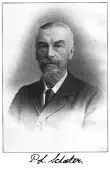
scientific classification:
– Order: Psittaciformes
– Family: Psittacidae
– Genus: Psittacara
– Scientific name: Psittacara holochlorus
– Citation: (Sclater, PL, 1859)
– Protonimo: Conurus holochlorus
Green Parakeet pictures:
Sources:
– Avibase
– Parrots of the World – Forshaw Joseph M
– Parrots A Guide to the Parrots of the World – Tony Juniper & Mike Parr
– Birdlife
– Photos:
(1) – Green Parakeet From The Crossley ID Guide Eastern Birds By Richard Crossley (Richard Crossley) [CC BY-SA 3.0], via Wikimedia Commons
(2) – Green Parakeet by Vince Smith – Flickr
(3) – Aratinga verde by G. Lasley/Vireo – audubon.org
(4) – Aratinga verde by G. Lasley/Vireo – audubon.org
(5) – Aratinga holochlora (Psittacara holochlorus) – Bellas Aves de El Salvador –
– Sounds: Peter Boesman (Xeno-canto)
